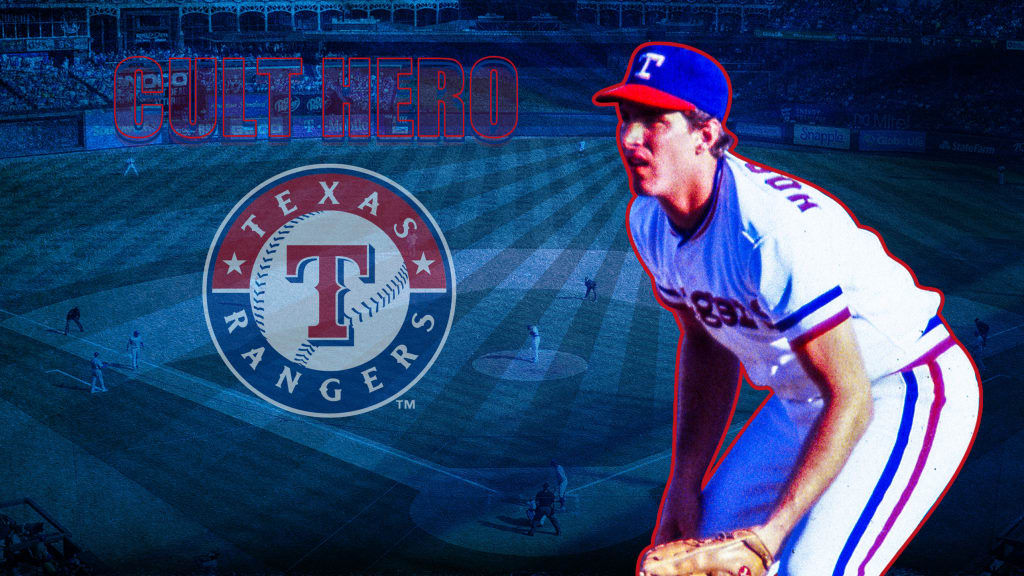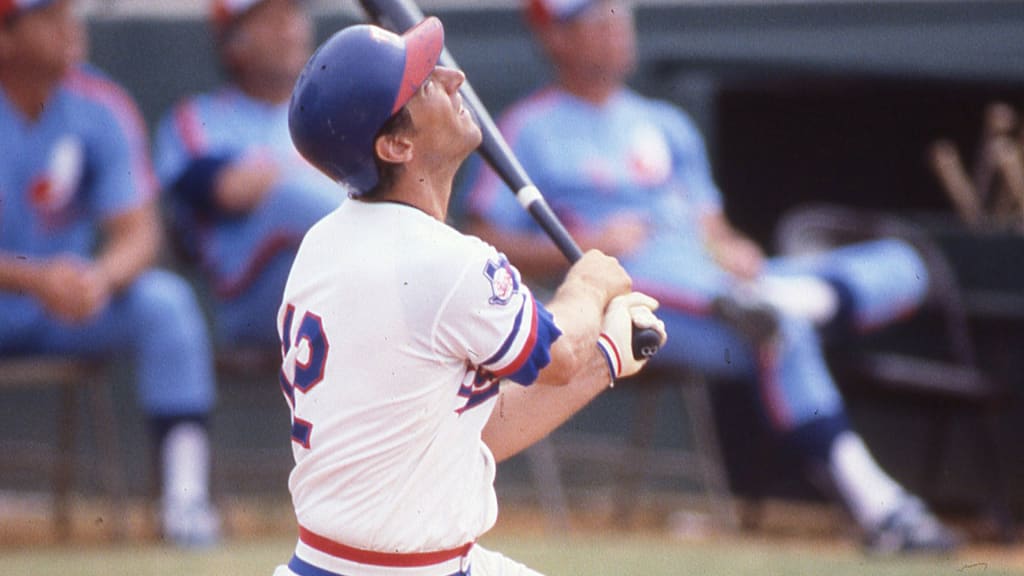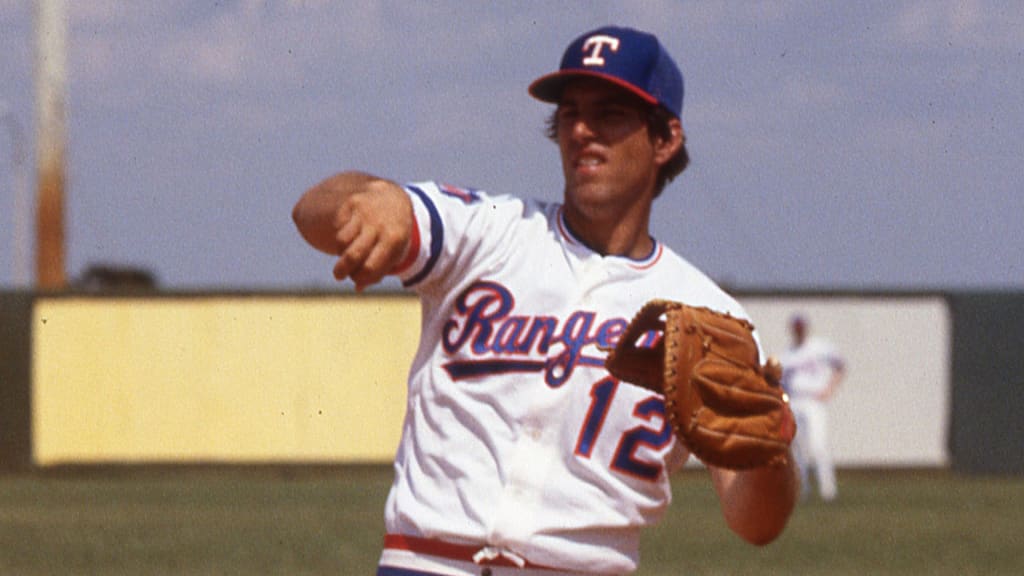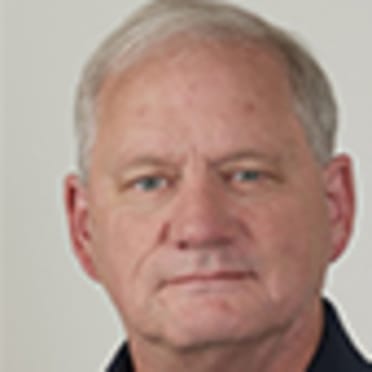
ARLINGTON -- Red Sox outfielder Jim Rice was considered one of the premier power hitters in the Major Leagues, but Rangers manager Don Zimmer had a prediction about the future Hall of Famer and rookie first baseman Dave Hostetler.
“You put Dave Hostetler in a home run contest with Jim Rice for 10 minutes and Hostetler will hit more,” Zimmer said.
Few were willing to dispute that while “Hoss-steria” was sweeping through North Texas in the summer of 1982, an entire Major League franchise seemed to be energized by a soft-spoken but powerful 6-foot-4 slugger from Southern California with a jaw-dropping ability to crush a baseball.
“He went nuts,” former Rangers catcher Jim Sundberg said. “He hit home runs, drove in runs, won games for us. I remember George Brett hitting .400 for two months when [the 1985 Royals] won the World Series. What he and Hoss did over a two-month period were probably the two most phenomenal things I’ve ever seen in baseball. It was awesome.”
The hysteria reached its peak when the Rangers started playing the theme song to "Bonanza" when Hostetler came to the plate. The connection to the character of “Hoss” on the popular TV western was obvious, and there is reason to believe it was the first walkup song ever devoted to a single player.
“We were looking for help and somebody who could really energize our lineup,” third baseman Buddy Bell said. “The Rangers had never really had anything like that. It’s always going to be a football area but that might have been the first time people really got excited about the Rangers. We had always had some good players, but nothing like that.”

The excitement didn’t last long. Within two years, Hostetler was back in Triple-A and his time with the Rangers was over.
“What he did for two months was truly remarkable,” said Jim Reeves, longtime baseball writer for the Fort Worth Star-Telegram. "It’s hard to believe it went south. He went from the greatest hitter in baseball to he couldn’t hold his spot on the team. I hated that. He was so down to earth. He never let his brief flirtation with fame go to his head. I wanted so hard for him to succeed.”
Hostetler’s amazing summer is not forgotten. If there ever was a “cult player” on the Rangers who captured the fans’ imagination, it was David Alan Hostetler.
“It was an incredible time,” Hostetler said in a lengthy interview this offseason. “I just got off to a great start. Things were clicking. I felt comfortable up there and did really well. I had always been a streaky hitter, even in the Minor Leagues. I would get on a hot streak and do well for a month, a month and a half, and then I don’t know if I was trying too hard or trying too much, thinking too much, I really don’t know.
“That was a frustration for me for a long time: Why couldn’t I make adjustments and do the things I needed to do to stay in the big leagues?”
The frustration no longer bothers him. The one-time Rangers phenom who took North Texas by storm and disappeared almost as quickly has never left.
He and his wife, Susan, still live in the same south Arlington home they bought in 1982 from former Rangers pitcher Doc Medich. He has spent the past 20 years as a regional manager for Riddell, the sporting goods company that specializes in football helmets. He has two sons: Brian, an accountant in Fort Worth, and Kevin, an international recruiter for the University of Southern California admissions office.
Hostetler attends Rangers alumni events and plays in the occasional charity golf tournament with other retired players in North Texas. He is still asked about that sensational summer of 37 years ago.
“Sure, people still talk to me about it,” Hostetler said. “They don’t recognize me as much anymore, but people come up to me and say, ‘Yeah, I remember you got off to a great start.’ They still remember that stuff. Yeah what happened was frustrating, but I wouldn’t trade the years I had playing baseball for anything.”
SOUTHERN CALIFORNIA KID
Hostetler played football and baseball at Arcadia High School just outside Pasadena, in the shadow of the Rose Bowl. He wasn’t that good of a baseball player, didn’t make varsity until his senior year and didn’t really blossom until that summer while playing on an American Legion team.
“Things started to click,” Hostetler said. “I was going to play football at Citrus Junior College, and by the end of the summer, I wanted to play baseball.”
Hostetler talked to Citrus College coach Skip Claprood, a legend in Southern California baseball circles who welcomed him to come out. The Owls needed a first baseman and they found a good one. Hostetler flourished at Citrus and attracted the attention of Evo Pusich, an astute scout for the Giants who had discovered Bobby Bonds many years earlier.
The Giants twice drafted Hostetler while he was at Citrus, but he did not sign. Instead, he went to USC and played for two years under another legendary coach, Rod Dedeaux. Hostetler was a member of the Trojan squad that won the 1978 College World Series, and he hit a home run in the championship game against Arizona State.
“Probably the best experience I ever had in baseball,” Hostetler said.
After turning down the Giants one more time as a junior, Hostetler was drafted by the Expos in the fourth round of the 1978 MLB Draft. He joined an organization that had one of the best farm systems in the game. Hostetler played with Tim Raines and Tim Wallach on a 1980 Denver Bears team that went 92-44 and was ranked 37th all-time by MiLB.
So deep were the Expos that Hostetler had to stay in Denver in 1981 while hitting .318 with 27 home runs, 103 RBIs and a .568 slugging percentage. An Opening Day home run in Denver landed 20 rows beyond in straightaway center field.
He was called up to the big leagues in September. The Expos were in a tight division race and didn’t clinch a spot in the postseason until the next-to-last game of the season. Hostetler, after a few pinch-hitting appearances, finally played the last game and hit his first home run off Mets pitcher Pete Falcone.
“All the veteran players were up in the clubhouse still celebrating,” Hostetler said. “But when I hit that home run, everybody came down to the dugout to congratulate me. I will never forget that.”
TRADE RUMORS
The Expos lost in the National League Championship Series but came back with a strong team the following year. They just needed another big bat and one possible target was Al Oliver with the Rangers.
“There were all the rumors that Al Oliver was going to be traded,” Hostetler said. “In Spring Training, Larry Parrish was the guy the Rangers were looking at. There was a lot of talk. I was there but didn’t think much about it, never really heard my name with any of that stuff. I had a great spring, played a lot and got some big hits. Got down to the end of Spring Training and I was thinking, ‘I’ve got a chance to make the team with Montreal.’”
Rangers general manager Eddie Robinson really wanted Yankees outfielder Oscar Gamble, who had played briefly in Texas in 1979 before being traded to New York. As Spring Training progressed, the two teams reached an agreement with Oliver going to the Yankees for Gamble, outfielder Bob Watson and pitcher Mike Morgan.
Gamble, however, did not have fond feelings about his brief time in Texas. He especially wasn’t thrilled that the prevailing south winds blowing in from the outfield made Arlington Stadium difficult for hitters. He exercised a no-trade clause, which infuriated owner George Steinbrenner, and Gamble would be punished for his impudence by spending the summer on the Yankees bench.
Robinson turned his attention to the Expos and met with Montreal general manager John McHale in West Palm Beach. Robinson wanted Parrish, who had been an All-Star third baseman. The Rangers had Bell but thought Parrish could fit in right field, a position he had played in the Minor Leagues. Hostetler was a relative unknown despite two good Triple-A seasons in Denver and was not connected to any of the rumors.
Robinson was able to get both, surprising his own staff. The trade of Parrish and Hostetler to Texas for Oliver came down on March 31, 1982, just 10 days before Opening Day.
Tom Grieve, who had just begun his post-playing career as an assistant in the Rangers' farm system, admitted he didn’t know much about Hostetler at the time.
“But when you watched him play and watched him hit, when he first got here, the reaction was, ‘Wow, this could be the steal of the century,’” Grieve said. “Looks like we got a guy who can hit in the middle of the order, be a 25-30 home run guy. He became a fan favorite, he had long-ball power and there was no reason to believe it wasn’t going to last for a long time.”
Radio broadcaster Mark Holtz knew about Hostetler. The Rangers had just hired Holtz from Denver to work with Eric Nadel, and he had watched Hostetler play for two years.
“Mark told me, ‘This kid Hostetler is going to hit a lot of homers and they are going to go a long way,’” Nadel said.
The Parrish-Hostetler trade was not the only blockbuster made by the Rangers at the end of Spring Training. The day after getting Parrish and Hostetler, Robinson agreed to send top pitching prospects Ron Darling and Walt Terrell to the Mets for outfielder Lee Mazzilli.
Wayne Krivsky, whose long and distinguished career included three seasons as the Reds general manager, was an assistant for Robinson at the time. He was in a meeting with Robinson, Zimmer, pioneer sabermetrician Craig Wright and senior advisor Paul Richards when the prospective trade was discussed.
“Eddie went around the room and asked for everybody’s opinion,” Krivsky said. “Asked if they would do the trade. Zimmer said yes. He just wanted somebody he could pencil into the lineup. Paul and Craig both said yes. Then Eddie asked me and I said, ‘No way.’
“The funny thing was the year before was the strike year and both Eddie and Paul Richards spent that time watching our Minor Leagues. They both came back raving about Darling and Terrell. Said they were the best they had ever seen. So when I brought that up to Paul, he looked at me, took a drag off his cigarette and said, ‘Wayne, they’re just prospects.’”
Joe Klein, the Rangers farm director, was holding a meeting when he was informed of the trade. Klein was irate.
“Gentlemen,” Klein announced to his staff. “This meeting is over. We are going to the bar.”
Mazzilli, an All-Star center fielder with the Mets, also had to change positions. The Rangers had George Wright to play center so Mazzilli was asked to move to left. He hated it, proclaiming left field was “an idiot’s position.”
HIGH HOPES
Still, the 1982 Rangers began the season with high expectations. They had just missed the postseason the year before under MLB’s split-season format devised after the player’s strike and appeared ready to win. Skip Bayless of the Dallas Times Herald wrote a column predicting the Rangers would win the division.
“It was supposed to be our year,” Sundberg said
Hostetler began the year in the Minors. Ironically, he was sent to Denver since the Rangers had just replaced the Expos as the Triple-A team there.
Hostetler’s path to the big leagues was blocked by Pat Putnam, another first baseman who came to the big leagues with high expectations. Putnam had been the Sporting News Minor League Player of the Year in 1976 in the Western Carolina League and the magazine’s Major League Rookie of the Year in '79 with the Rangers. Over his first three years in the big leagues, Putnam had put up solid, if not spectacular numbers and seemed locked in at first base.
“I didn’t make the club right away, they sent me down,” Hostetler said. “Pat was there. Went back to Denver, which was a good thing because all the people knew me there. Made the most of it and got off to a good start.”
Putnam did not, and neither did the Rangers. By the end of May, they had lost 27 of their first 40 games and Putnam was hitting .210 with a .321 slugging percentage. He was demoted, and Hostetler, who had hit 12 home runs in 36 Triple-A games, took his place.
Hostetler was excited about the promotion but he was given a warning upon arriving in Arlington. Denver was Denver, a place where balls went soaring in the high altitude. Arlington Stadium was different. There the south prairie wind blew hard in from center field.
“It was really just not a good place for power hitters,” Bell said.
Jeff Burroughs, the 1974 American League MVP, hated the place so much he begged the Rangers to trade him. Richie Zisk signed a 10-year contract with the Rangers after hitting 30 home runs for the White Sox in 1977. He lasted just three years in Arlington Stadium before being traded to the Mariners.
“Those guys told me the first day I was there, it’s not a good hitter’s ballpark,” Hostetler said. “They told me right away, Jeff Burroughs hated this place. That south wind, the flags, blew in every single day. I might have hit a couple of balls that might have been home runs somewhere else, but I don’t think that was a big thing for me.”
HOSS-STERIA
Hostetler was 0-for-3 against Paul Splittorff and the Royals in his first game on May 29 at Arlington Stadium. The next day he hit a home run off rookie right-hander Keith Creel, who was from nearby Duncanville.
“I know I hit it to dead center field in old Arlington Stadium,” Hostetler said. “That was a great feeling.”
Hostetler was only warming up. He hit back-to-back home runs on June 12-13 against the Twins and two more against the Mariners on June 15 in the Kingdome. After the game, Zimmer compared him to Frank “Hondo” Howard, one of the strongest players ever to play the game.
On June 21, the Rangers opened a three-game series against the Angels in Anaheim, just a half-hour south of Arcadia. Family and friends made the trip for all three games and Hostetler was 0-for-9 in the first two. Then he broke out and hit two home runs in the final game of the series.
Then came back-to-back home runs on June 26-27 against the Athletics in Arlington. That Saturday game drew 30,728 fans to Arlington Stadium, only the third time in their first 35 games the Rangers drew over 30,000.
“Things were just clicking,” Hostetler said. “I can still remember Sundberg, those guys helping me, what the guy was throwing, what’s his best pitch, what’s he going to try and do.”
By the end of June, Hostetler had played in 28 games and was hitting .273 with 11 home runs, 22 RBIs and a .687 slugging percentage. The Rangers were 15-13, and Hoss-steria was everywhere.
The Rangers began playing the "Bonanza" theme song when Hostetler came to the plate. For over a half-century, baseball had been stuck on organ music as the in-game entertainment. The Athletics finally began jazzing up the Oakland Coliseum with recorded up-beat rock music in 1980 as “Celebration” by Kool and the Gang became their theme song.
But Hostetler is believed to be the first player to have his own walkup music.
“I would be shocked if we were the first ones, but he was the only one we did it for,” said Dave Fendrick, who was the Rangers' director of marketing at the time. “It was just the connection. He was Hoss and there was Hoss on 'Bonanza.' It was just that simple. At the time, they just couldn’t get him out.”
Rangers fans loved it.
“It was amazing,” Hostetler said. “There was a lot of stuff in the media and the newspapers, that the Rangers had found something. I can remember just being able to go to the ballpark and people talking about Hoss-steria. It was pretty cool. I thought that was a neat thing. They never did that before in the Minor Leagues.
“I can remember once in the Minor Leagues they had this deal where they came on in the seventh inning and said, ‘If Dave Hostetler strikes out in this at-bat, beer is free.’ I can remember that distinctly and I’m thinking, ‘I’m not going to let that happen.’ Stuff like that happened in the Minor Leagues. They would never do that in the big leagues.”
Hostetler cooled off in July, hitting just three home runs in 30 games. Then he heated up again for a few weeks in August. He hit two home runs against the Yankees on Aug. 1 in Arlington and then three more during a five-game series Aug. 5-9 during his first visit to Yankee Stadium.
Back in Arlington, he had another memorable moment on Aug. 17, when he hit a three-run home run in the bottom of the 11th off White Sox reliever Dennis Lamp to give the Rangers a 4-3 victory.
THE END CAME QUICK
The home run was Hostetler's 22nd of the season. It was also his last. Hoss-steria was coming to an end. Both Robinson and Zimmer had been fired, the Rangers went into a freefall and Hostetler did not hit a home run in his last 135 at-bats.
“I just didn’t make the adjustments,” Hostetler said. “Because basically when you look at all these guys, that’s the guys who stay for a long time, the ones who make adjustments. I came up at same time as Cal Ripken, and I saw him have different stances, different swings, different approaches to the game.
“I had a hard time with that. When they found out the things that you could do and the things that you can’t do, you get the steady diet of breaking balls. That was probably the biggest frustration that I had playing, that I couldn’t make adjustments.”
The Rangers still held out hope the next spring that Hostetler would get it turned around.
“I remember in Spring Training,” Krivsky said, “Joe Klein said to me, ‘Wayne do you think Hostetler is the real deal?’ I said, ‘Yeah, I’m liking what I’m seeing,’ Joe said, ‘Yeah, I think he is the real deal, too.’”

Doug Rader had been hired as manager and Merv Rettenmund was the hitting coach. Hostetler was his No. 1 pupil but it didn’t help. Rookie Pete O’Brien was installed as the first baseman and Hostetler was limited to designated-hitter duty. He hit just 11 home runs in 94 games in 1984.
“Part of my problem was thinking too much,” Hostetler said. “Thinking about what these guys were trying to tell me to do. When you get up to the plate in the big leagues, if you’re thinking, you’re done. You’ve got to just react, see the ball where they’re trying to pitch to you.
“I can remember Doug Rader saying, 'You’ve got to stop listening to everybody who is trying to help you.' Craig Wright, the statistician guy, was trying to do all this stuff. Merv, too. Rader finally looked at me and said, ‘Swing hard in case you hit it.’”
Hostetler spent most of 1984-85 in Triple-A, followed by two productive seasons with the Nankai Hawks in Japan. In another bit of irony, Putnam also spent the 1986-87 seasons in Japan with the Nippon Ham Fighters as his career, too, was coming to an end.
Hostetler got one more brief chance with the Pirates in 1988 but the magic was long gone.
By that time, Arlington Stadium had undergone major renovations, including the installation of outfield billboards that blocked the prairie winds. The old ballpark was no longer a place where home run hitters foundered in the breeze.
Then the Rangers moved into the Ballpark in Arlington and, in another cruel twist of irony, the configuration and further renovations of the place would turn Globe Life Park into a hitter’s paradise. The dreaded prairie winds that bedeviled Burroughs and others would become the jet stream to right field. Alex Rodriguez, Josh Hamilton and many other sluggers would thrive there.
No telling what it would have done for someone like Hostetler. Unfortunately, he was a slugger way ahead of his time. But for two months in the summer of 1982, Dave Hostetler was as huge as they came for the Rangers.
“It was too bad,” Sundberg said. “I know he was really frustrated. He was such a great guy, and everybody wanted him to do well. I don’t know what happened, maybe they stopped throwing him fastballs and he couldn’t lay off the breaking balls away. Who knows? But it was phenomenal while it lasted.”



